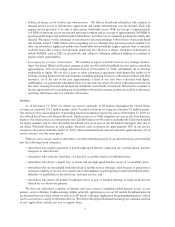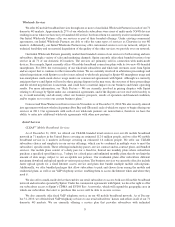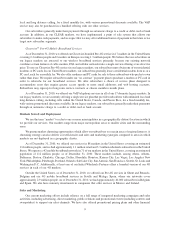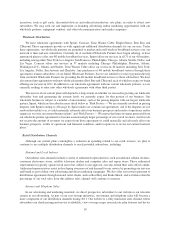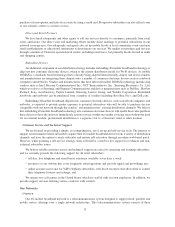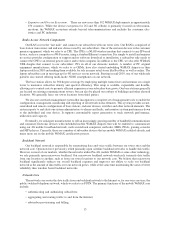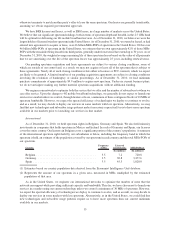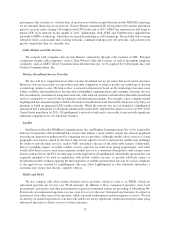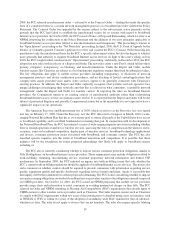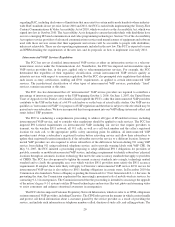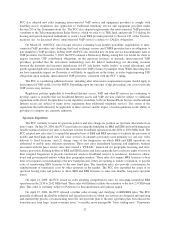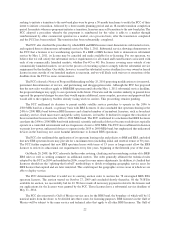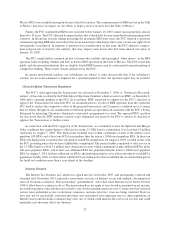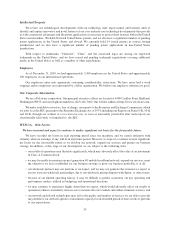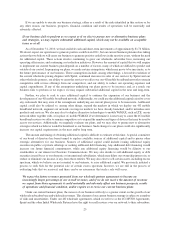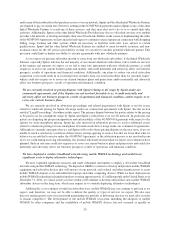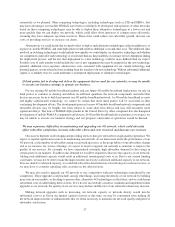Clearwire 2010 Annual Report Download - page 22
Download and view the complete annual report
Please find page 22 of the 2010 Clearwire annual report below. You can navigate through the pages in the report by either clicking on the pages listed below, or by using the keyword search tool below to find specific information within the annual report.performance that is similar to, or better than, or may be more widely accepted than the mobile WiMAX technology
we are currently deploying on our network. Verizon Wireless launched LTE in December 2010 and has announced
plans to cover its entire existing 3G footprint with LTE by the end of 2013. AT&T has announced it will begin to
deploy LTE on its network by the middle of 2011. Additionally, both AT&T and T-Mobile have upgraded the
networks to HSPA+ technology, which they are currently marketing as a 4G technology. The mobility and coverage
offered by these carriers under their existing networks, combined with their new 4G networks, will provide even
greater competition than we currently face.
Cable Modem and DSL Services
We compete with companies that provide Internet connectivity through cable modems or DSL. Principal
competitors include cable companies, such as Time Warner Cable and Comcast, as well as incumbent telephone
companies, such as AT&T, Qwest Communications International, Inc. (to be acquired by CenturyLink, Inc.) and
Verizon Communications, Inc.
Wireless Broadband Service Providers
We also will face competition from other wireless broadband service providers that use licensed spectrum.
Moreover, if we are successful, we expect these and other competitors to adopt or modify our technology or develop
a technology similar to ours. We believe that, as network infrastructure based on 4G technologies becomes more
widely available and manufacturers develop and sell handheld communications and consumer electronic devices
that are enabled to communicate using these networks, other network operators will introduce 4G mobile broadband
services comparable to ours in both our domestic and international markets. For example, a new company named
LightSquared has announced plans to build a 4G wireless broadband network that will be wholesale-only. They are
planning to build an integrated LTE-satellite network. While the network has not yet launched, LightSquared
announced that it anticipates it will launch commercially in mid-2011, and that it has plans to cover over 90% of the
United States population by 2015. If LightSquared’s network is built and is successful, it may provide significant
additional competition for our wholesale business.
Satellite
Satellite providers like WildBlue Communications, Inc. and Hughes Communications, Inc. (to be acquired by
Echostar Corporation) offer broadband data services that address a niche market, mainly less densely populated
areas that are unserved or underserved by competing service providers. Although satellite offers service to a large
geographic area, latency caused by the time it takes for the signal to travel to and from the satellite may challenge
the ability to provide some services, such as VoIP, and reduces the size of the addressable market. Additionally,
there is a pending request of mobile satellite services operators for relief from gating requirements; such relief
would allow them to move away from a primary satellite service to a terrestrial offering that could compete more
directly with us. In fact, the FCC recently approved the application of LightSquared, which holds spectrum that was
originally intended to be used in conjunction with mobile satellite services, to provide wholesale service to
broadband providers without requiring the full integration of satellite and terrestrial services. If various conditions
to the approval are satisfied by LightSquared, this may allow LightSquared to offer wholesale subscribers a
terrestrial only service that directly competes with us.
WISPs and Wi-Fi
We also compete with other wireless Internet service providers, which we refer to as WISPs, which use
unlicensed spectrum for services over Wi-Fi networks. In addition to these commercial operators, many local
governments, universities and other governmental or quasi-governmental entities are providing or subsidizing Wi-
Fi networks over unlicensed spectrum, in some cases at no cost to the user. Unlicensed spectrum may be subject to
interference from other users of the spectrum, which can result in disruptions and interruptions of service. We rely
exclusively on licensed spectrum for our networks and do not expect significant competition from providers using
unlicensed spectrum to deliver services to their customers.
17


